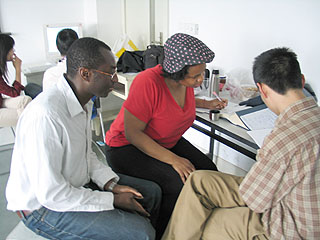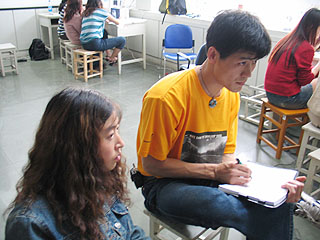The Otolith Group, Kodwo Eshun (English, culture critic,
tutor DAI) and Anjalika Sagar (English, artist, guesttutor DAI)
Workshop :
THE ART OF THE ESSAY FILM
Duration :
8 days
Participants:
approx. max. 20 (NAI 15 / DAI 5)
The workshop will introduce students to the art form of the essay film. As a cinematic form, the essay film tends to move between the traditions of documentary cinema and speculative cinema, thereby opening a continuum between the poetic and the political, the personal, the geopolitical, the intercultural and the archival.
Viewing these films can suggest ways that audio-visual practice may begin to revise the past and imagine the future so as to intervene in the present.
DAY 1 MORNING: LECTURE AND SCREENINGS
Kodwo Eshun and Anjalika Sagar will present an opening lecture on the history of the essay film. Excerpts from some or all of the following essay films will be screened.
- Joris Ivens: Valparaiso (1963)
- Louis Malle: L’Inde Phantom/Phantom India (1969)
- Michelangelo Antonioni: Chung Kuo Cina (1972)
- Chris Marker: Sans Soleil (1982)
- Dan Graham: Rock My Religion (1982-1984)
- Black Audio Film Collective: Handsworth Songs (1986)
- Trinh T. Minh Ha: Surname Viet Given Name Nam (1989)
- Johan Grimonperez: Dial H for HISTORY (1997)
- Jean Luc Goddard: Histoire(s) du Cinema (1998-1997)
DAY 1 AFTERNOON: SCREENING AND DISCUSSION
Kodwo Eshun and Anjalika Sagar will screen their new film Otolith (2003) and discuss the contemporary reworking of the essay film.
DAY 2 MORNING: DISCUSSION
The students and tutors will discuss the processes of research, archive and memory that emerge from the films viewed on Day 1
DAY 2 AFTERNOON: METHOD AND PRACTICE
The students will be prepared for the practical stage of the workshop and advised as to how they might begin to make their own short essay film on the theme of discontent The theme may be interpreted as microscopically or macroscopically as the student wishes. The theme of discontent is intended as a means of focus
DAY 3 MORNING: PLANNING
The students will be asked to form themselves into 2 groups, the size of which depends upon the number of participants. Each group will be supplied with a mini DV camera with which to direct a 4 minute essay film on the theme. The session will be devoted to the planning a feasible filming schedule for the remainder of the workshop.
DAY 3 AFTERNOON, DAY 4, DAY 5 MORNING:
Shooting footage
DAY 5 AFTERNOON: VIEWING
The tutors will view the material and advise on the editing process
DAY 6, DAY 7,DAY 8 MORNING: EDITING
Each group will picture edit on Final Cut Pro. Any group that wishes to narrate and record a voiceover script must schedule time accordingly.
DAY 8 AFTERNOON: PRESENTATION
The groups present their work. The workshops require a technician or an editor conversant with Final Cut Pro editing software or an equivalent editing technology. The number of editors depends on the number of participants in the workshops. The editors may be students that wish to focus exclusively on the process of editing.
Report on the workshop

by the Otolith Group, Kodwo Eshun and Anjalika Sagar
Five Groups - five films
The Otolith Group, Kodwo Eshun and Anjalika Sagar were invited to China to conduct the workshops at the Nanjing Arts Institute that lasted for 8 days during the five weeks of April 2004. The workshops produced five digital videos by five groups that are being exhibited here in the show Under Construction at the Nanjing Arts Institute. The Under Construction show marks the end of this five-week process of collaboration between the students, teachers and the institutions of NAI and DAI.
The workshop process
ESSAY FILMS SCREENED DURING WORKSHOPS
Night and fog - Alain Resnais (1955)
2 or 3 things I know about her - Jean-Luc Godard (1966)
A grin without a cat - Chris Marker (1977)
Handsworth songs - Black Audio Film Collective (1985)
Sans soleil / sunless - Chris Marker (1982)
Histoir(es) du cinema - Jean-Luc Godard (1988)
Shoot for the contents - Trinh T. Minh-Ha (1991)
In the name of God - Anans Patwarhan (1991)
Dial H H-I-S-T-O-R-Y - Johan Grimonperez(1997)
Otolith - The Otolith Group (2003)
We planned the workshops in stages - the first stage being to introduce a series of works that would contextualize a history on the essay film and deliver a conceptual framework. The films presented span 50 years of significant cultural and socio political forces within a series of decades from the end of the second world war to the present era of the continual war, the pre emptive strike and the cooperate takeover. The films we showed were accompanied by a lecture that was delivered by Kodwo Eshun.
In the second stage we attempted to bridge the cultural gap between the students by dividing them into five groups consisting of both the DAI students and the NAI students. We then began a series of discussions that emerged out of the films and provided the opportunity for the students to consider issues of identity, social reality, art, memory, the archive and the local and global. Furthermore we also initiated discussions on the traditions and tensions of the first world and developing world and how that might influence the process of the groups practice.
The students who have been with us through this process consisted of students both from the Dutch Art Institute and the Nanjing Art Institute. All the students from DAI that are in this workshop come from a variety of different countries. Strangely none of them are Dutch, all the students from the Nanjing Art Institute are Chinese and also come from a variety of differing locales from across Mainland China. We expected that we would have to simplify the process of the workshop as we were conducting the workshops through translation. We were obliged to rethink the conceptual frame we had devised back in the UK. We decided to create a context in which cross-cultural translation functioned as the basis for a reflection on the nature of sound and image in contemporary culture.
The workshop was designed to encourage a selfconscious and critical approach to the image. The aim was to create conditions for the students to use sound, image and text to ask questions, about themselves, each other, media and social reality. The 3 minute restriction was intended to focus these questions.
The process lasted for five days and was followed by a filming period in which the groups were asked to gather and research text, sound and image for their film. This lasted for a period of several days during which the various members of groups were obliged to participate in other workshops. Nevertheless they continued to meet and discuss their materials and prepare an editing procedure.
The final stage of the workshop involved the groups editing the materials gathered and applying a conceptual frame to the process. The work that is on exhibit here has emerged out of these workshops on the Art of The Essay Film.



